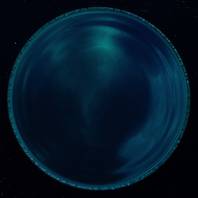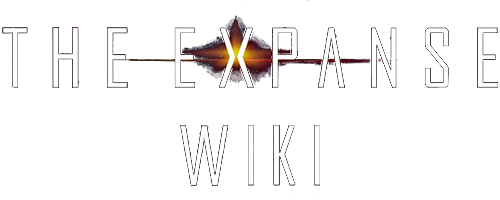The Ring network, alternately known as the Gate network, Gateway network, or the wormhole network, or simply collectively referred to as the gates, is an ancient complex system of 1,373 artificially sustained traversable wormholes that connect star systems across the Milky Way galaxy. Credited with its creation, the Ring Builders used this enormous network to expand beyond their home star system and, eventually, establish a thriving interstellar empire around 2,000,000,000 BCE, dominating the Milky Way. The network managed to survive even after the Ring Builder empire's dissolution.
The Ring network represents the pinnacle of transportation technology, rendering feasible effective superluminal travel and the subsequent galactic colonization.
Overview

The Sol Ring.
Specifications
Rings are represented by a torus shape, with twisting ridges that continuously spiral around its body, possibly to prevent the wormhole from ever collapsing. Their inner diameter is roughly one thousand kilometers. The Rings themselves seem to be constructed from a highly resilient material that does not erode over the course of millions, even billions, of years. Evidently, the Ring causes spatiotemporal disturbances, anticipating the wormhole from far away. This distortion can be observed when electromagnetic radiation enters and exits the wormhole. It is unknown whether there are discrepancies between local observers and actual passengers aboard a ship regarding transit times, though this possibility is mostly excluded.
An object traveling through a Ring treats the wormhole as a higher-spatial corridor between the linked points, effectively reducing transit times to near-zero values, though time does elapse. Sensor data, including visible light, behave accordingly, treating Rings as windows between two points, without being atomically harmed in any way.
Hub
- Main articles: Slow Zone, Ring Station
The Rings each lead to a location possibly in intergalactic space, colloquially known as the Slow Zone. At the center of the region, the Ring station is located, the central control station of the network. From there, the Rings themselves can be deactivated and voluntarily cease their respective wormholes. However, the structures themselves remain intact. A subsequent reactivation is possible, as evidenced by James Holden and the Investigator.
History
Human speculation
Einstein's Theory of Relativity was the first pivotal step that humanity took towards truly comprehending the universe. It postulated that gravity was a consequence of spacetime curvature. This approach remained unchallenged until the effects of quantum gravity were recorded. Theoretical physicists speculated that reconciling quantum laws with general relativity would give humanity a complete understanding of gravity and its associated consequences and, thus, control over it. Such a degree of control was considered at the time to enable circumvention of the lightspeed barrier through the use of shortcuts in spacetime, otherwise known as wormholes. However, while progress might have been made, a complete reconciliation of gravity was still not achievable by the 24th century.
Discovery
After completing its life cycle on Venus by accumulating sufficient component material, the protomolecule built a megastructure on the outskirts of the Sol system. Said structure was later revealed to be an artificially-sustained wormhole gate leading to a starless region of space.
Known Rings
 Sol gate
Sol gate
The Sol Ring is the initial Ring discovered by humanity, and the only one to be referred simply as "the Ring". It is located two astronomical units outside the orbit of Uranus. It is the product of a complex of self-assembling structures that emerged from Venus after the protomolecule seeded the planet via Eros.
 Ilus gate
Ilus gate
The gate to the Ilus system was one of the first extra-solar gates accessed by humanity. It was first traveled through by refugees that had escaped the conflict over Ganymede. Not unlike the Ring in Sol, its Ilus counterpart is located on the outskirts of the system, but an asteroid belt is known to orbit Ilus' star ever further out than the gate[1].
 Laconia gate
Laconia gate
The gate leading to the Laconia system which contains the habitable planet Laconia. When Admiral Duarte defected from the Martian Congressional Republic, he convinced one third of the entire MCRN Fleet to cross through the Laconia ring to establish a new empire, with himself as the leader. A repeating message was sent from the Laconian system side of the ring, back through the Slow Zone, warning others not to enter. All probes into the Laconia system were destroyed by Duarte's forces.
 Freehold gate
Freehold gate
The gate to the Freehold system, which contains three gas giants and a habitable planet. The Freehold gate provides access to one of the less established colonies which, by the time of the Laconia-Sol Conflict, was still heavily reliant upon resources from other systems.
 Castila gate
Castila gate
The gate to the Castila system. The system holds a colony and was served by the freighter Savage Landing.
 Auberon gate
Auberon gate
The gate leads to the Auberon system which has a colony that traded with Freehold.
 Arcadia gate
Arcadia gate
Leads to the Arcadia system.
 Eudoxia gate
Eudoxia gate
 Charon gate
Charon gate
A Gate that leads to a dead system[2].
 Adro gate
Adro gate
A Gate that leads to a dead system[3].
 Naraka gate
Naraka gate
A Gate that leads to a dead system[4].
Notes and trivia
- In the novels, the Ring network made its first appearance in Abaddon's Gate. In the TV series, the gates appeared for the first time in Episode 10 of the third season. [5]
See also
References
- ↑ The Expanse Novel: Cibola Burn
- ↑ The Expanse Novel: Persepolis Rising, chapter 1 - Drummer
- ↑ The Expanse Novel: Persepolis Rising, chapter 1 - Drummer
- ↑ The Expanse Novel: Persepolis Rising, chapter 1 - Drummer
- ↑ Tony Ianni on Twitter
